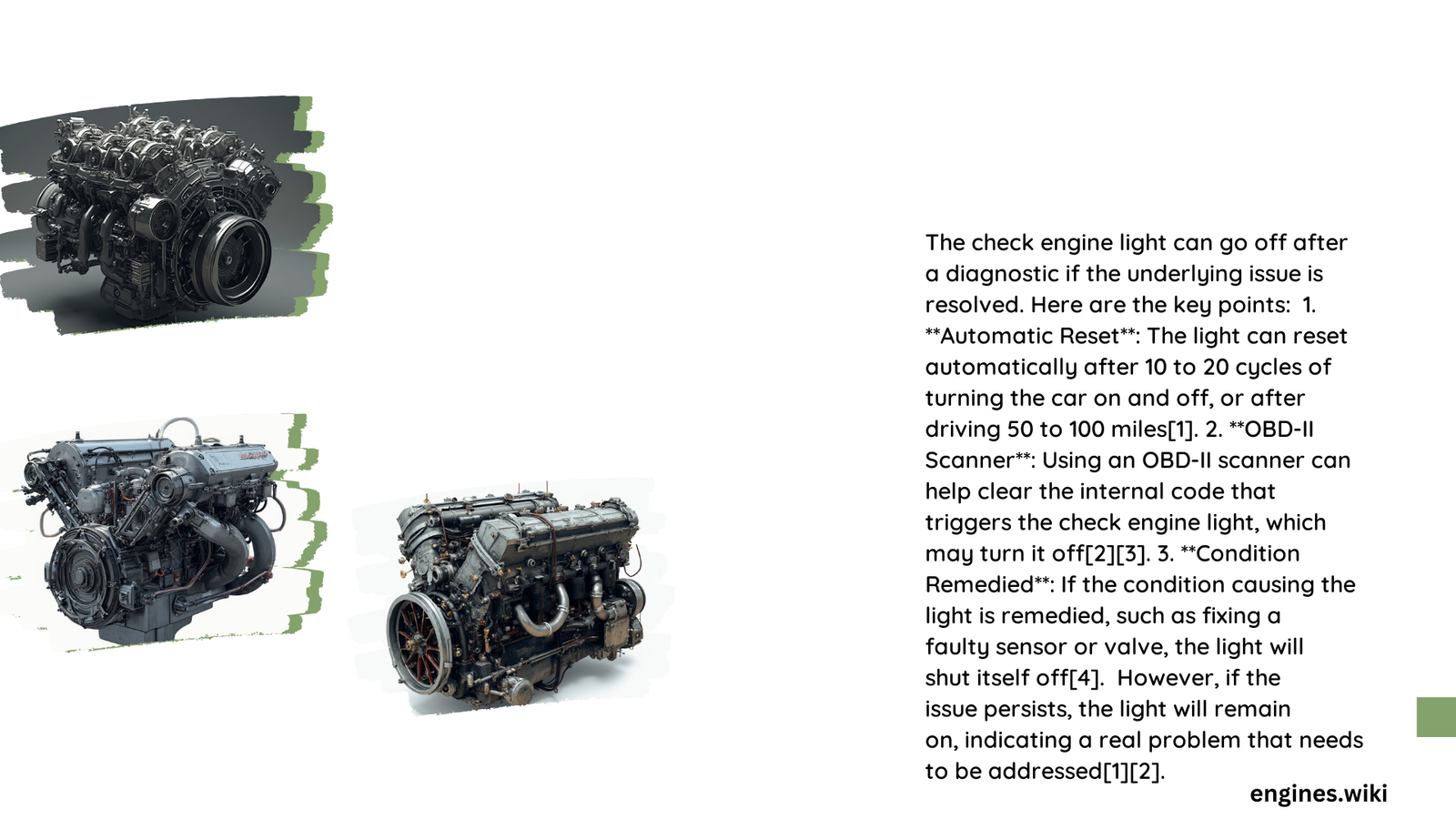The check engine light is a crucial indicator of your vehicle’s health. Many drivers wonder if this light automatically turns off after a diagnostic scan. The short answer is no, it doesn’t. A diagnostic scan alone doesn’t reset the check engine light. The underlying issue must be resolved, and the error codes need to be cleared manually. This process involves using an OBD-II scanner or alternative methods to reset the light after addressing the problem.
What Happens During a Diagnostic Scan?
A diagnostic scan is the first step in identifying why your check engine light is on. Here’s what typically occurs:
- The OBD-II scanner is connected to your vehicle’s diagnostic port.
- The scanner reads the error codes stored in the car’s computer.
- These codes provide information about the specific issue triggering the light.
However, simply reading these codes doesn’t automatically turn off the check engine light.
Why Doesn’t the Light Turn Off Immediately After a Scan?

The check engine light remains on after a diagnostic scan for several reasons:
- Persistent Issue: The underlying problem hasn’t been fixed yet.
- Code Storage: The error codes remain stored in the car’s computer.
- System Design: The light is designed to stay on until manually reset.
How to Turn Off the Check Engine Light After a Diagnostic?
To turn off the check engine light after a diagnostic, follow these steps:
- Address the underlying issue identified by the diagnostic scan.
- Clear the error codes using an OBD-II scanner or alternative methods.
- Verify that the light stays off after resetting.
Using an OBD-II Scanner
- Connect the scanner to the OBD-II port.
- Turn on the ignition (don’t start the engine).
- Follow the scanner’s instructions to clear the codes.
- Disconnect the scanner and start the engine to check if the light is off.
Alternative Methods
If you don’t have an OBD-II scanner, you can try these methods:
- Battery Disconnection: Disconnect the car battery for about 15 minutes.
- Key Cycle Method: Turn the ignition on and off three times in quick succession.
- Drive Cycle: Drive the car for several days after fixing the issue.
Note that these alternative methods are less reliable and may not work for all vehicles.
What Are Common Issues That Trigger the Check Engine Light?
Understanding common triggers can help you address the root cause:
| Issue | Common Code | Description |
|---|---|---|
| Loose Gas Cap | P0455 | Indicates an evaporative system leak |
| Faulty Spark Plugs | P0300 | Indicates random engine misfires |
| Malfunctioning O2 Sensor | P0133 | Indicates slow oxygen sensor response |
| Catalytic Converter Issues | P0420 | Indicates catalyst system efficiency below threshold |
| Mass Airflow Sensor Problems | P0101 | Indicates mass airflow sensor range/performance issue |
When Will the Check Engine Light Remain On Despite a Reset?
In some cases, the check engine light may persist even after attempting a reset:
- Unresolved Issues: If the underlying problem isn’t fixed, the light will reappear.
- Serious Problems: Critical issues may prevent the light from resetting until resolved.
- Incomplete Reset Process: Improper reset procedures can fail to clear the light.
- Pending Codes: Some issues leave pending codes that trigger the light after several drive cycles.
What Are the Benefits of Professional Diagnostic Services?
While DIY diagnostics are possible, professional services offer several advantages:
- Accurate Diagnosis: Professionals have advanced tools for precise problem identification.
- Comprehensive Scans: They can detect issues beyond basic OBD-II codes.
- Expert Interpretation: Mechanics can interpret codes in the context of your vehicle’s history.
- Efficient Resolution: They can quickly address issues and properly reset the system.
- Warranty Preservation: Professional service helps maintain your vehicle’s warranty.
How Often Should You Perform Diagnostic Scans?
Regular diagnostic scans can help maintain your vehicle’s health:
- Annual Check: Perform a scan at least once a year, even without a check engine light.
- Pre-Purchase Inspection: Always scan a used car before buying.
- After Major Repairs: Scan after significant engine or electrical work.
- Performance Changes: If you notice changes in fuel efficiency or performance, conduct a scan.
What Are the Potential Costs of Ignoring the Check Engine Light?
Ignoring the check engine light can lead to:
- Decreased fuel efficiency
- Reduced engine performance
- Increased emissions
- Potential for more severe and costly damage
- Failed emissions tests in some regions
Conclusion
The check engine light doesn’t automatically turn off after a diagnostic scan. It requires addressing the underlying issue and manually clearing the error codes. While DIY methods exist, professional diagnostic services offer more comprehensive and accurate results. Regular scans and prompt attention to the check engine light can save you money and maintain your vehicle’s performance in the long run.
References:
1. How to Reset a Check Engine Light – TrueCar Blog
2. Guide to Reset Check Engine Light: With & Without Tools | dubizzle
3. How to Reset the Check Engine Light with an OBD2 Scanner – cgsulit
